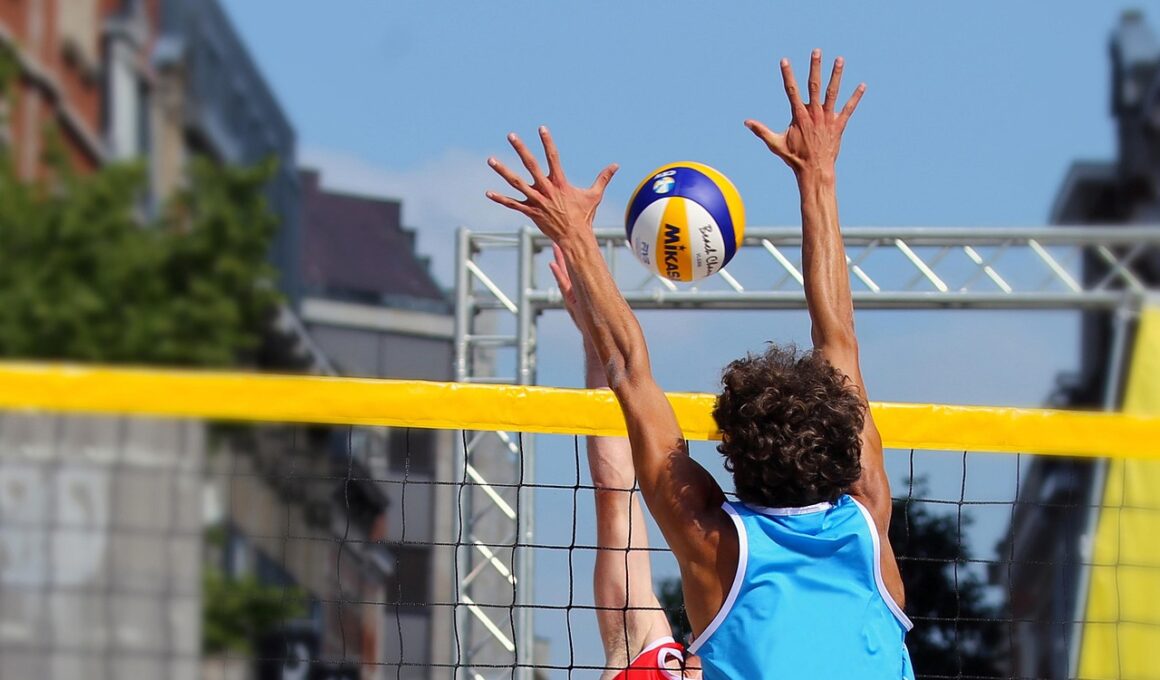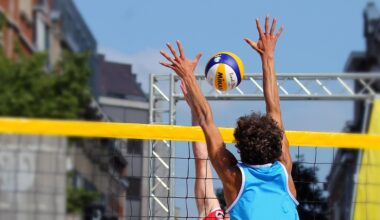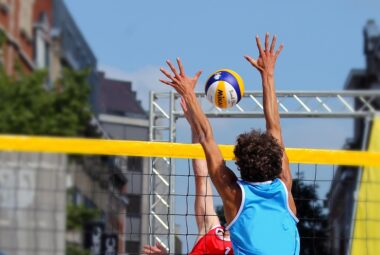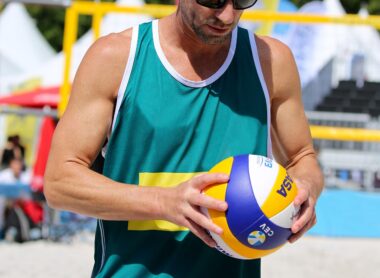How to Read Opponents’ Defense as an Outside Hitter
Understanding the opponent’s defensive setup is crucial for an outside hitter. First, take time to observe their positions before the serve. Note where the libero and middle blockers are located on the court. Their placement can indicate potential weaknesses you can exploit. Second, pay attention to how they react to different plays. This includes noting any shifts in their positions during rallies. By doing so, you create mental notes which can aid your approach on attack. Third, your own positioning is key. Remain aware of the net and your teammates’ location to facilitate effective communication. Consistent observations will also help you gauge the defenses’ tendencies over time. Consider also using a system to track their patterns during practice. For example, record the defensive formations in a notebook or digital form. This research can be incredibly helpful during games both for strategy and confidence. Next, when you step up to serve or receive, use previously gathered information. Attempt to identify the blockers’ likely movements to successfully determine your own actions. Reacting quickly and thoughtfully to these cues will significantly enhance your gameplay.
Furthermore, the communication on the court is paramount in reading defenses effectively. As an outside hitter, you should maintain ongoing dialogues with your setter and other teammates. It helps if you use codes or calls for different plays based on the situation. Pay attention to the setter’s signals, as they can guide you where to hit. A clear understanding of each player’s qualities can also aid your reading. For instance, if your setter is preferred for high balls, adjust your approach accordingly. Anticipation works hand-in-hand with observation; don’t wait until the last moment to decipher the defense. Cultivating chemistry within the team can enhance your overall performance. Always keep an eye on weaknesses in the defense. For example, if one player consistently fails to cover a certain area, focus on that spot when attacking. Such insider knowledge maximizes point potential and boosts confidence as a hitter too. Additionally, trust your gut feelings mixed with analytical skills. This balanced approach helps point out the smallest flaws in a defense that bigger assessments may overlook, starving opponents of advantage and granting you momentum in matches.
Utilizing Video Analysis for Better Reading
Incorporating video analysis can significantly enhance your ability to read defenses for outside hitters. Reviewing footage of games allows you to dissect opponent tendencies outside the live experience. Focus on formations, block patterns, and individual player movements. This insight enables you to predict future plays confidently. While analyzing the video, note the setup during a range of circumstances. Observe what type of attack worked best against their specific lineup in various situations. Such detail provides actionable insights to test at subsequent practices. Look for little things, such as predictable foot movements and arms positioning. Checking for communication styles on the opponent’s side can also reveal opportunities. When considering defensive switches during gameplay, analyze how quickly the players adjust as this will help you exploit weak spots in real-time. Pair video analysis with discussions among teammates afterward to share impressions and refine your strategies. Utilize this resource efficiently; it’s not merely for individual assessment but enhances team success as well. This forward-thinking approach will lead to unprecedented advancements in your game, translating into effective scoring opportunities when needed most.
Additionally, practice scenarios mimicking potential match conditions can greatly improve your reads. The goal is to develop strategies under different competitive environments. Use drills focused specifically on reaction times and anticipation. For example, create situations where your teammates execute various plays leading to different defensive reactions. Each spike can correspond to specific reads that require immediate decision-making. Incorporating game-like constraints during practice emphasizes the crucial observatory skills needed in matches. Even simulated pressure scenarios can help you prepare for actual games. This preparation enables your mind to process events quickly, instinctively responding to shifting defenses when it matters most. Furthermore, diligently practice visual cues and reaction drills with your team. The synergy developed through these exercises will enhance your instincts and foster solid teamwork amongst players. Encourage feedback to bolster collective decision-making, reinforcing the idea that reading defenses is a team effort. As you build stronger skills in these areas, your ability to react rapidly and accurately during live matches will markedly increase your effectiveness as an outside hitter.
Mindset and Confidence Building
Mental preparation is just as vital as physical training when it comes to reading defenses. Cultivating a winning mindset prepares you for anything the opposing team throws at you. Visualizing success before games can build self-assurance and reduce anxiety about poor reads. Picture yourself executing effective plays, making quick assessments, and responding adeptly. Such mental rehearsal helps you remain calm and focused under pressure. Moreover, engage in regular positive self-talk as you prepare for any performance challenges. A confident hitter can set a definitive tone, influencing not just your performance but also inspiring teammates. Additionally, remember that every opponent plays differently. What worked yesterday may not work today, so remain flexible in your thinking. Treat each match as an avenue for learning, regardless of the outcomes. Creating an adaptable mindset enhances your skill to read additional layers of nuance in enemy defenses. Moreover, find time for relaxation and recovery, which will enhance mental agility. A refreshed mind translates to sharper instincts. Consider engaging in mindfulness practices, such as meditation. This will allow you to hone your focus, thus improving your ability to perceive crucial cues effectively in matches.
Another vital aspect is the role of body language in reading defenses as an outside hitter. Learn to observe your opponents intensely during warm-ups and before serves. Body language, such as how players position themselves or where they glance, can indicate their defensive strategy. Is the middle blocker showing signs of anticipation or hesitation? Such elements can be instrumental in deciding your next move in a split-second situation. Develop intuition when identifying players’ mental states from their movements. Develop the skill to differentiate between fatigue and strategic deception in their positioning. Additionally, maintain a posture that showcases your readiness as well. Adopting a confident stance affects not only your performance but can create doubt in your opponent’s minds as well. Repeatedly analyze the defenses you encounter in practice through body language recognition exercises. This builds a bridge between the visible cues and your strategic decision-making. By integrating observations of body language with technical drills, you create a holistic training approach. Such thoroughness builds adaptability, enabling you to attack confident effectively regardless of the opposing team’s configurations, thus elevating overall performance in games.
Conclusion: The Continuous Journey of Improvement
In conclusion, mastering the ability to read opponents’ defenses as an outside hitter is an ongoing journey. Each aspect we’ve discussed is interconnected, blending strategy with mental fortitude. Never rest on your laurels; preparation and adaptability are key in constantly evolving your game. Keep enhancing training methods, from video analysis to on-court drills. The ability to continuously learn and adapt in the heat of competition sets elite players apart from the rest. Conversations with teammates can amplify your observations, enriching overall game comprehension. Mindset cultivates resilience, allowing flexibility even amid changing defenses. As such, build a strong foundation of trust and communication within your team. Share insights and discoveries, fostering a culture of growth. Always remain focused on your opponents without losing your individuality as a player. Trust yourself and your preparations; your analytical skills will serve you well under pressure. Read, react, and continue to evolve your technique on the court consistently. As you do, you’ll find that reading defenses becomes second nature, leading not only to personal triumphs but also to broader team success and victories.
Lastly, remember that every match presents a unique challenge and endless opportunities. Every opponent will differ, bringing new schemes and techniques to the court. Use this diversity to your advantage; adapt your strategies based on your ongoing assessments. Proactive anticipation and a keen insight into the passing play are vital. The fusion of these skills will develop into instincts formed from countless repetitions. Effective communication will remain a key player in your success. Make it a habitual practice to discuss performances post-match with your team. Analysis and discussion lead to better group understanding and improvement in subsequent games. Emphasize the lessons learned from wins, as well as losses. Such efforts build camaraderie and strength among players as they face competition together. Each experience can act as a stepping stone toward improving skills and strategies. This commitment to growth, reflection, and strategizing is what will ultimately elevate your status as an outside hitter. The pursuit of excellence on court should be a relentless goal. Take each encounter as a chance to sharpen your instincts, leading to greater success both individually and collectively in the sport.





